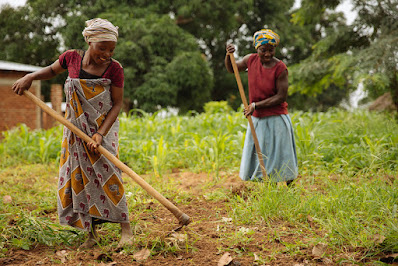Water Storage: More Than Dam it
We may conclude from the broad data discussions in previous posts that managing water and food security in Africa is complex and requires localised oversight. In this and the following post, I'll move to several potential solutions towards agriculture-related water shortages, as well as their impact and limits, using particular case studies.
In most African countries, the economy and livelihood systems are strongly reliant on rainfall (Boelee et al., 2013), which is inherently unevenly distributed in both time and space. Approximately 200 million people in sub-Saharan Africa are food insecure, owing to a reliance on unreliable rain-fed agriculture (Ward et al. 2007). According to existing studies (e.g., Thornton et al., 2006), current climatic variability in Africa will be worsened by future climate change, which implies water resource managers on the continent will have to deal with increasing water resource uncertainty.
Physical water scarcity is not the most significant limiting factor in access to water in most African regions. Rather it is the economic scarcity caused by insufficient investments in water infrastructure. Africa only owns a small proportion of large-scale water dams in the world (less than 2,000 of the 45,000 globally; Hanjra et al., 2009). In light of this, building water storage systems to artificially reallocate water supplies from wet to dry seasons is becoming a key mechanism for averting droughts and hunger on the continent.
Reservoirs are usually the first thing that comes to mind when it comes to water storage used for balancing seasonal water inequities. Indeed, alternative storage methods range from manmade small-scale tanks to natural storage like soil moisture and wetlands (Figure 1). During dry seasons, any of these kinds can operate as a buffer, supplying water for agriculture and other needs. Of course, each type of water storage has its own niche in terms of technological feasibility, socio-economic viability and influences on the environment. However, the value of small-scale artificial storage and natural storage is often neglected, as will be discussed in the following test.
Small Scale Artificial Storages
Reservoirs hold water impeded by dams built across streams and rivers. Large reservoirs are often multifunctional, as they not only offer water for local use but also assist hydropower generating and flood control. Small reservoirs are typically formed by constructing simple earth dams. They tend to be shallow wide, so a substantial amount of water may be lost due to evaporation. Ponds and tanks are 'off-stream household or community-built water stores filled wither by rainwater harvesting, surface runoff or through groundwater infiltration' (Johnston & McCartney, 2010). Similar to small reservoirs, evaporation loss is their common limitation.
In large-scale evaluations of agricultural water supply and demand, rainwater gathering in small reservoirs is frequently disregarded (Wisser, 2009). Small-scale artificial water storage has a number of advantages, including being a decentralised system that allows individuals and communities to manage their own water for their own purposes, rather than having to consider trade-offs between different managed purposes as large-scale water regulation projects must (Johnston & McCartney, 2010).
On the other hand, small storages are prone to public health hazards caused by vector-borne illnesses. According to an analysis taken in Ethiopia (Boelee et al., 2013) the rush to build water storage for climate change adaptation may put already vulnerable African populations in danger, thus environmental and health considerations should be taken into account while constructing small scale water storages.
Naturally Formed Storages
Groundwater, soil moisture and natural wetlands are common types of storage that could support agriculture production, which are all of great importance for Africa.
Take groundwater as an example, the amount
of groundwater stored in aquifers in Africa is 100 times the total annual renewable
freshwater resources in the continent, according to MacDonald et al. (2012). With
the addition of a low evaporation rate, groundwater is a significant buffer for
rural Africa, which is also the only water source for 80% of the population in sub-Saharan
Africa (Johnston & McCartney, 2010). Wetlands are natural harvesters of
rainwater and are of great significance in arid and semiarid regions, as they could
retain water at or close to the ground surface for long periods. Wetland
ecosystems in African are estimated to cover more than 131 million hectares (WI,n.d.), delivering a wide range of eco-services including small-scale agriculture.
Overall, African water managers must integrate the management of various forms of water storage. Water-stressed countries might benefit greatly from careful examination and utilization of small-scale and natural water storage.





Great post! I agree that there should not be one fixed management strategy for all water stressed regions, as water storage is a localised issue and therefore should have localised small-scale management strategies.
回复删除Thank you for taking the time to leave a comment! Yes I was also inspired when writing this post - many small scale management solutions can generate huge impacts as well!
删除